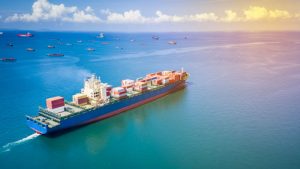Scrubbers, an essential complement for ships wishing to reduce their sulphur emissions, will be a hot topic in 2019. The maritime sector is facing a restructuring in order to do away with environmental contamination, which these systems will play a key role in.
What is a scrubber and how does it work?
Also known as gas scrubbers, scrubbers are atmospheric emission purification systems. Their technology allows the ensuing contaminating emission to be stalled and that are as harmful to the atmosphere as sulphur emitted by ships. Shaped like a cylindrical tank, Scrubbers capture this gas and neutralise the pollutants components using liquid.
The liquid may be water, a chemical reagent or a mixture of both, depending on the contaminants to be treated. Nitrogen derivatives can be absorbed in an acid medium, while the sulphur derivatives can be removed in an alkaline or oxidant medium. There are even certain very water soluble contaminants that do not require the use of chemical reagents in the washing process.
However, the result of the contact of liquid with the gas is always the same: namely, the separation of the contaminating molecules. This allows us to obtain a clean, non-toxic gas that can be emitted to the atmosphere.
The role of scrubbers in terms of IMO regulation
Applying this technology to ships allows us to obtain sulphur-free gas that meets the objectives of the IMO’s sea transport decarbonisation goals. This puts into context the rise of these scrubbers one year on from the sea fuel sulphur limit regulations. From 2020 onwards, the options will involve using less polluting fuels or decontaminating the traditional ones.
Many ship-owners have already started to use these contaminant gas washing systems. According to figures from consultancy firm Drewry’s report, 266 container ships are equipped with scrubbers, a total capacity of 2.2 million TEU. This also involves a penetration largely involving large vessels, so that while only representing 5% of all vessels, it is about double in terms of capacity.
Dangers involved in the implantation of scrubbers
Having stressed the importance of the convenience of installing this type of system, it is important to highlight the risks involved in the hasty adaptation of the vessels through scrubbers. The most obvious one is economic, arising from its proper installation and subsequent use. A price to pay that is compounded by uncertainty about future environmental regulations.
A key element in the profitability of the scrubbers is the availability of high sulphur fuel oil (HSFO). Thanks to the implementation of scrubbers, vessels may continue to use this type of fuel. However, it is difficult to gauge future demand and its subsequent price. HSFO estimates were lower for 2020 in relation to other fuels which comply with the 0.50% sulphur emission limit, but a boom in the implantation of scrubbers could mean that demand remains high and there is no reduction.
Another aspect is the ship maintenance by-product. Several trade routes could be affected by a build-up of ships undergoing a restructuring process involved the installation of scrubbers. The installation of these purification systems takes up to six weeks, which can impact on their capacity to transport goods.
The greatest danger is for the East-West connections, as only 17% of the vessels travelling between Asia and the Mediterranean used this system up to November, according to data from Drewry. There is about a 10% rate of implementation between Asia and North America, while connections between Asia and northern Europe are down as far as 5%. The ships covering these routes must therefore be taken out of service over the coming months, a process that could lead to lower rates of use and increased freight rates.


